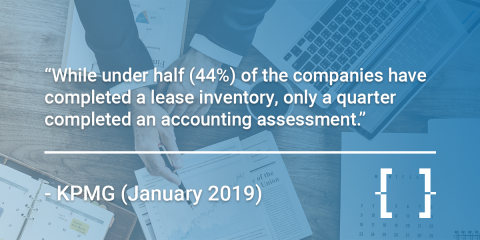
Lease Accounting
Leasing is a common financial solution that is used by most organisations. It enables companies to use real estate properties, assets and equipment without initial investments and large initial cash outflows. Leasing is also a common practice to increase portfolio flexibility and to free up financing for investments in the core business.
The regulatory lease accounting standards ASC 842 and IFRS 16 as set forth by the US based Financial Accounting Standards Board (FASB) and allied International Accounting Standards Board (IASB) drastically changed the way leases are treated in accounting, and the lease accounting changes have a significant impact on a company’s balance sheet and financial position. According to KPMG, just 3% of companies have fully completed their lease accounting compliant projects (January 2019). In this article you can learn more about the changes in lease accounting, regulations & standards and the potential impact for your organisation.
What is the difference between operating and finance lease?
There are two kinds of lease accounting classifications: operating and finance lease. An operating lease is treated as operational expenditure only, based on straight lined payments. A finance lease (also called capital lease under FASB) is a capitalised liability and right-of-use on the balance sheet, thus affecting profit and loss (P&L).
According to research by PwC, real estate properties and assets can today represent between 1 and 66% of the balance sheet. This wide range in percentage indicates differences in ownership status; some organisations prefer to own their real estate, on-balance, and others have chosen to rent their properties and assets as operating leases, off-balance.
This lease accounting practice has been questioned by accountants for many years. How realistic are the financial statements on the balance sheet when an on-balance owned property or asset could be sold within a few months while an off-balance operating lease contract could represent a liability for many years ahead? Operating leases have been adopted for many good reasons related to liquidity and increased ability to invest in core business activities. However, it has made it difficult to calculate and disclose a true and fair view of an organisation’s finances. Future liabilities emerging from these operating leases are not represented on the balance sheet. Listed companies using IFRS standard or US GAAP are estimated to have around US$3.3 trillion of lease commitments; over 85% of which do not appear on their balance sheets (IFRS Foundation).
Learn more about Lease Accounting

TIP
Driven by IFRS 16 compliance, in 2016 TIP started a project to assess the impact on its financial statements based on the full retrospective transition approach. TIP selected Planon Universe because of its full cloud deployment.
Explore now
Lease Accounting: How the lessons learned by Heineken, PwC and Planon could accelerate your IFRS 16 implementation
Has your organisation already successfully implemented the new IFRS 16 regulations? If not, this joint webinar by Heineken, PwC and Planon could be of great value for you, providing practical information on how to accelerate your IFRS 16 implementation. 51:37 English
Read more
How new lease accounting standards will impact your business
There have been a lot of changes in lease accounting since 2019. Starting 1 January 2019, the Financial Accounting Standards Board (FASB) and the International Accounting Standard Board (IASB) implemented new standards, ASC 842 and IFRS 16 respectively. Download a free copy of this FAQ to get an overview of five frequently asked questions about lease accounting and our answers to them.
Read moreLease accounting standards: IFRS 16 and ASC 842
What are the important changes in lease accounting?
1. Operating lease on balance sheet.
Lease accounting standards changed under IFRS 16 and ASC 842, and alter the way properties, and tangible and intangible assets are recognised for leases. In the previous situation, as described in IAS 17 (IFRS) and ASC 840 (FASB), operating lease obligations were not on the balance sheet whereas financing leases were. Operating leases were only disclosed in the footnotes of the organisation’s financial statements. The latest lease accounting standards IFRS 16 and ASC 842 ensure that lease liabilities are reflected in a more uniform way. All asset and property leases with lease terms of more than 12 months are recognised under IFRS 16 as a right of use and liability on the balance sheet. Under ASC 842 leases need to be classified and recognised on the balance sheet as operating leases or finance leases.
PwC research has shown that the increase in interest-bearing debt will mount to 58% on average but could increase by more than 200% for industries with many leased properties and assets. Related financial indicators like a company's Earnings Before Interest, Taxes, Depreciation, and Amortisation (EBITDA), leverage and solvency will change accordingly. The latest lease accounting standards leave some room for interpretation but require an assessment as part of the lease management process and clear documented arguments and decision frameworks to ensure compliant reporting.
2. Capitalisation of more cost factors according to IFRS 16 lease accounting standards.

3. Inclusion of lease extensions and indexations.
Optional extension periods need to be included in capitalisation when ‘reasonably certain’. This leaves space for interpretation and a significant compliance risk at the same time. During assessments of the financial reporting by accountants, the argument for eventual exclusion needs to be accepted. Specific attention is required to the impact of indexations. Under the IFRS 16 lease standard, any changes in the index require a complete recalculation, which can increase the volatility of lease accounting figures of right of use and liability.
4. Disclosures and SOX compliance.
In addition to the recognition of leases on the balance sheet, the latest ASC 842 and IFRS 16 lease accounting standards also require additional disclosures. These are designed to help investors and other stakeholders to understand property and asset related lease liabilities, the timing of financial commitments and aspects of uncertainty around cash flows arising from leases. In most cases, this additional information has to be Sarbanes Oxley (SOX) compliant, which in turn implies the need to track and record all changes on lease contracts and to prove that decisions have been made in an authorised way.
5. IFRS 16 and ASC 842 require more accuracy in the lease administration process.
The IFRS 16 and ASC 842 lease accounting systems demand the capitalisation of almost all real estate, property and asset leases and require the registration of additional lease related information. This will impact the day-to-day business of lease administration and associated IT solutions. The requirement to disclose information on the timing and uncertainty of cash flows requires a more detailed registration of lease data. Since the financial impact of lease renewals has fundamentally changed, lease scenario planning, balance modelling, and assessments are important in the decision making process that will include involvement from the controller and CFO.
Are you already compliant with IFRS 16 and ASC 842?
The ASC 842 and IFRS 16 lease standards became effective for public companies in the fiscal year 2019 but also included the need to report on regulations over the financial years from 2017. During the transition period between 2017 and 2019, the reporting requirements as defined by IAS 17 and ASC 840 were still effective, so a twofold lease calculation and reporting was required, without a double payment and accounting. Organisations must make sure they have a reliable lease accounting software solution.
Lease accounting software in IWMS
With the upcoming changes in lease accounting, organisations need a tool that enables them to make integrated decisions about their portfolio and asset strategy, lease renewals and lease proposals presented in the language of senior business management, controllers, accountants and other financial professionals. The impact of a lease renewal on the costs and liabilities can be significant and needs to be calculated and reported in a compliant way.
The new requirements for lease accounting as set forth by ASC 842 and IFRS 16 require a precise administration of all lease contract related costs and payments in a ‘time-lined’ way. This calls for professional lease administration software as available in a mature Integrated Workplace Management System (IWMS). Lease accounting is an important additional solution that can be used as a specific accounting system for controllers, or implemented on top of the lease administration in IWMS. In both cases with seamless integration to your financial system.

Global success stories

Stark Group selects Planon’s Lease Accounting solution to comply with IFRS 16 standards
Stark Group, one of the largest retailers and distributors of building materials for the professional segment in Northern Europe, has selected Planon Universe for Financial Professionals to comply with IFRS 16 standards.
Read more
Refresco
Refresco has more than 1,800 leased assets worldwide. In order to get compliant with the new IFRS 16 lease accounting standards, all external reports needed to comply with the new regulations.
Explore now
The University of Texas System Tackles GASB 87 Compliance with Planon
Planon announced that The University of Texas System has selected Planon’s Lease Accounting solution to adhere to the GASB 87 lease accounting standard for public organisations in the United States.
Read more



















